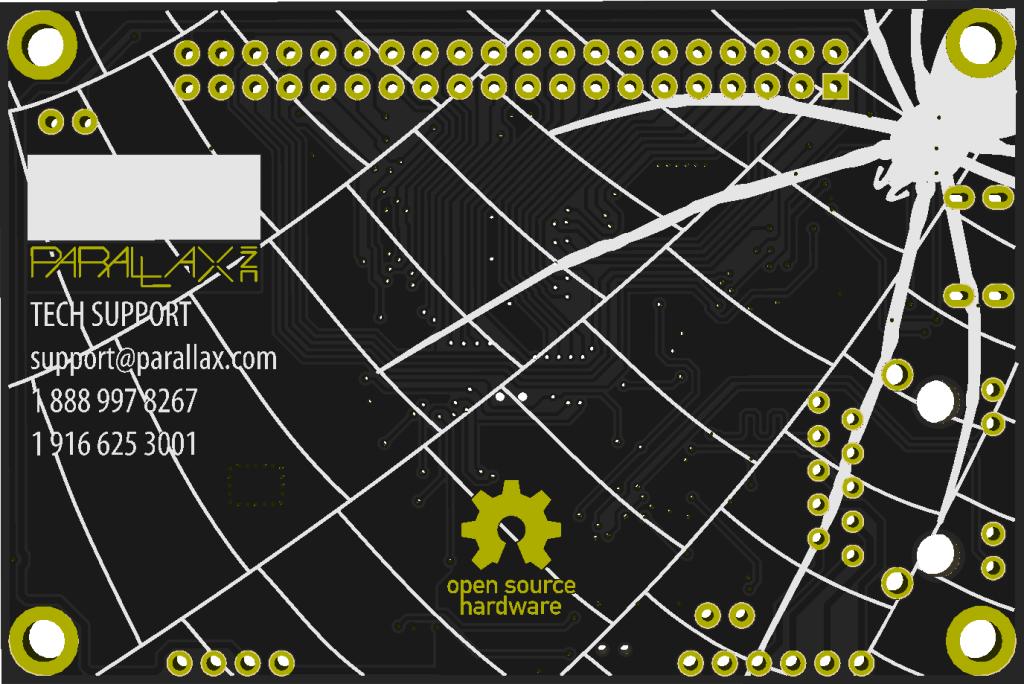Guess what I'm working on. (Revealed: Spinneret Web Server 2.0)
 David Carrier
Posts: 294
David Carrier
Posts: 294
I'm ordering prototype PCBs for a new product I'm developing, and I realized it's rare that I've gotten this far into development without posting on the forums and seeking feedback. Rest assured that it incorporates lots of input from forums members, but there was enough preemptive feedback that I didn't have to ask any specific questions. I want to see if the design has met everyone's expectations, so I'm going to perform a test to see if it's up to it.
I have attached a rendering of the back side of the new product's PCB. Tomorrow I'll post the front side and a list of all of the features and capabilities. Until then, post what you think it is and what features you think it has. There are some obvious clues and some subtle clues in the rendering, but there are also some features that are not apparent from the image alone.
David Carrier
Parallax Inc.
I have attached a rendering of the back side of the new product's PCB. Tomorrow I'll post the front side and a list of all of the features and capabilities. Until then, post what you think it is and what features you think it has. There are some obvious clues and some subtle clues in the rendering, but there are also some features that are not apparent from the image alone.
David Carrier
Parallax Inc.



Comments
Any new design surely should have a rPi IO connector footprint included ?
I second David's nomination.
An ethernet add on card for the QuickStart.
-Phil
(With apologies to Indiana Jones.)
Anyway, as with my others, my dime is on a Spinneret board for the QS. And I second Phil's request for stackable headers.
Quad SPI, of course ?
There's also a square arrangement of vias in the lower left area. Usually that's done to allow heat through, right? Maybe some kind of regulator or something?
Since it has the quickstart connector, you don't need to have a super lot built in to the board, you can just plug in something like the human interface board and or the memory card board.
The WiFi is more a wish, I don't think it is really there.
-Phil
http://www.silvertel.com/poe_products.htm#Ag8000
If it is, it will be very useful. Nice work, thanks David
You can get elevated headers easily enough - PC104 also uses a 40 pin elevated header.
edit: actually probably the newer and cheaper Ag9700 - http://www.silvertel.com/poe_products.htm#Ag9700
Alex
The clock chip is even right where he predicted, in the upper-left corner when viewed from the back. The two holes are for INT1 and INT2.
The only correction is that you cannot connect a Human Interface Board or Propeller Memory Card. As Phil Pilgrim pointed out: Not only is it physically incompatible with a Human Interface Board, the built-in circuitry uses half of the Propeller I/O pins, so it is also electrically incompatible. It will work with the QuickStart Proto Board if it is set up in an overhanging configuration. All of the I/O pins are connected to the header, but half are used by the built-in hardware. P0 through P15 are untouched and available for use on the QuickStart Proto Board or any purpose-built boards.
Don't worry about the inability to connect a Propeller Memory Card, because David Betz's hopes are true:
A latching microSD card socket and Quad SPI flash device share an SPI bus and the WIZnet device has its own SPI bus. It doesn't have dedicated SPI SRAM, but Mike G brought up a good point: It does ahve a W5500, so you can use any unused buffer space as general-purpose SPI SRAM.
Back to the real-time clock, instead of a supercapacitor, it has a socket for a CD-2032 battery. It takes up about 20% of the left side of the board (again when viewed from the bottom) and that is why it is mostly empty there. The PCB space does double as a heatsink for the 3.3 volt regulator, which will have to dissipate a bit more heat than the QuickStart did, because Ethernet circuitry can draw a few hundred milliwatts of power.
As a few of you noticed, there are solder points for a Silver Telecom PoE module. It will have to go on the underside of the board, because the top side is too full. The board also has the newer FT231X USB controller, so it can also draw power from a USB charger.
As for the name: bomber was right: we're calling it the Spinneret Web Server 2.0
As prommised, I have attached a rendering of the top side, as well as a placement diagram.
— David Carrier
Parallax Inc.